Bridgend, Wales, UK 作者: 来源: 发布时间:2021-09-18
I. Population and Area
Continent: Europe
Country: The U.K
State/Province: Wales
City/Town: Bridgend
Total Area: 2.51 (sq mi)
Population in 2011: 49.40 (thousand)
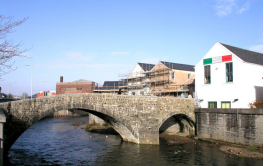
II. Natural Geography (environment and resources)
Rail
Bridgend railway station has regular services to Cardiff Central, Bristol Parkway and London Paddington to the east; Port Talbot Parkway, Neath, Swansea and the West Wales Line to the west; and Maesteg to the north. There are also services to Manchester Piccadilly. Bridgend is the western terminus of the Vale of Glamorgan Line which reopened to passenger traffic in 2005. Wildmill railway station, about 1 mile (2 km) north of Bridgend railway station, serves the estates of Wildmill, Pendre and Litchard and is on the Bridgend-Maesteg branch line. A park and ride station at Brackla, about 1.5 miles (2.4 km) south-east of Bridgend railway station is planned and is due to be constructed once capacity improvements have been made to the South Wales Main Line. Services to a new railway station in Llanharan began in December 2007.
Bus
Bridgend bus station has services to urban and rural areas in South Wales. Most services are operated by First Cymru. An east–west cycle route has been constructed from Brackla through to Broadlands and into Cefn Glas. Bridgend is on the National Cycle Route and there are off-road spurs from the Celtic Trail to the town centre and a community route in the Ogmore Valley. Glyncorrwg and the Afan Valley about 12 miles (19 km) north of Bridgend near Maesteg is famed for its mountain bike trails, considered amongst the best in Europe.
Air
For scheduled and chartered air travel, Bridgend is served by Cardiff International Airport, to which there are direct rail and bus services.
Geography
Bridgend remained a solid market town after the war. In 1948, Newbridge Fields (a short distance from the town centre) hosted the 1948 National Eisteddfod. In 1960, the River Ogmore burst its banks and flooded the town centre. Subsequent floods and extreme weather led the Welsh Water Authority to develop concrete flood defence walls along the banks of the River Ogmore in the town centre. The town centre has not been flooded since. During this time, Bridgend was chosen to become the headquarters for South Wales Police. This action was ideal as geographically, Bridgend stands equidistantly between Swansea to the west and Cardiff to the east.
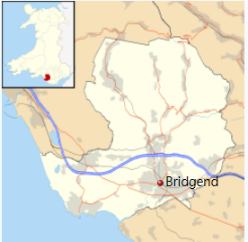
The Beeching cuts of the 1960s had the loss of passenger rail links in the Vale of Glamorgan and to the northern valleys. The Vale of Glamorgan link to Barry via Rhoose was reinstated in June 2005. In the 1970s, Bridgend began to see the catalyst of arguably its biggest growth period. The "missing section" of the M4 motorway was constructed around the town, plans were afoot to change the Waterton Admiralty into an industrial estate, and the water supply was improved including new sewage treatment works near Ogmore. Two major multinational corporations, the Ford Motor Company and Sony, set up factories in or on the outskirts of the new Bridgend Industrial Estate (former Waterton Arsenal).
The development of the Brackla Housing Estate in the 1980s, housing developments at Broadlands to the south-west of the town centre and the continuing expansion of Brackla to the north-east have caused Bridgend's population to swell dramatically. Due to this, traffic congestion and a lack of parking facilities within the town have become important issues in the area. In 1997, a new link road/bypass was built to link the town centre directly to the M4 motorway, as well as redirect traffic around the town centre.
A new Securicor-operated prison (HM Parc Prison) was built near Coity in the late 1990s. The prison opened in November 1997. The McArthur Glen Designer Outlet opened in 1998.
III. Economy
Average earnings and employment vary considerably across Wales. They are both generally higher in east Wales, especially in urban areas, but lower in south west Wales and the Valleys, although earnings in Bridgend and Neath Port Talbot, which are still centres of skilled manufacturing employment, are relatively high. In north and north west Wales, earnings are low but the employment rates are above the Welsh average.
A significant part of the earnings (and value added per job) variations within Wales are due to structural factors such as economic mass and occupational mix rather than like-for-like lower pay or productivity. Cardiff, with over 400,000 people, benefits from its size, capital status, a hinterland in south east Wales and good connections to London and the M4 corridor. Cardiff is the primary location for service sector activities in Wales, with 26% of Welsh service sector output and 22% of Welsh service sector employment, compared to 19% of all employment in Wales. North east Wales benefits from proximity to Cheshire, Greater Manchester and Merseyside and there is significant cross-border commuting. The Valleys and the western areas of Wales have less economic mass and are more distant from major economic centres. These are some of the poorest regions in Europe and qualify for Objective One funding.
Many parts of Wales suffered from a continuous decline in heavy industry over the 20th century, culminating in the virtual disappearance of coal-mining in the 1980s. The demise of 'smokestack' industries left a legacy of high unemployment, and although unemployment has declined in recent years, unemployment in West Wales and the Valleys still tends to be higher than the Welsh average and economic inactivity (a form of hidden unemployment) continues to be a major problem in these areas. Merthyr Tydfil and Neath Port Talbot have some of the largest proportions of people in the UK not working due to long-term illness or disability, though some believe that in reality many people classified as "unable to work" through sickness are low-skilled workers encouraged to exit the labour market by the benefits system as well as declining demand for their skills.
Regions (NUTS3) | GDP € (2013) | GDP per capita € (2013) | GDP € (2016) | GDP per capita € (2016) |
Isle of Anglesey | € 1.167 bn | €16,700 | € 1.305 bn | €18,600 |
Gwynedd | € 2.956 bn | €24,200 | € 3.224 bn | €26,000 |
Conwy & Denbighshire | € 4.246 bn | €20,200 | € 4.767 bn | €22,600 |
South West Wales | € 7.678 bn | €20,000 | € 8.723 bn | €22,700 |
Central Valleys | € 5.939 bn | €20,100 | € 6.812 bn | €22,900 |
Gwent Valleys | € 5.962 bn | €17,500 | € 6.923 bn | €20,200 |
Bridgend & Neath Port Talbot | € 6.016 bn | €21,500 | € 7.240 bn | €25,400 |
Swansea | € 5.532 bn | €23,100 | € 6.332 bn | €25,800 |
Powys | € 2.869 bn | €21,600 | € 3.134 bn | €23,700 |
TOTAL | € 71.396 bn | €23,200 | €81.683 bn | €26,200 |
IV. Industrial Characterisitics
Major industries:
Industrial era
The discovery of coal in the South Wales Valleys north of Bridgend had a massive impact on the town. The first coal mining operations opened north of Bridgend in the 17th century; the Llynfi Valley was the first to be industrialised. Bridgend itself never had coal deposits and remained a market town for some time, but the valleys of the three rivers grew into an important part of the South Wales coalfields. Ironworks and brickworks (notably at Tondu) were also established in the same period by John Bedford, although the ironworks faltered after his death and ceased operating entirely in 1836.
The Great Western Railway arrived and Bridgend was at the junction between the main London to Fishguard line and the branch to the three valleys. Frequent coal trains took coal down the valleys; and when the Vale of Glamorgan railway opened, coal could be sent directly to port at Barry or via other branch lines to Porthcawl.
Several quarries opened in and around Bridgend town centre; some remnants of these can still be seen today near Brackla. An engine works was opened in the town and a larger farmers' market also opened in the town centre, where it remained until the 1970s.
In 1801, the population of what is now Bridgend County was around 6000. By the beginning of the 20th century this had risen to 61,000. By this time Bridgend was a bustling market town with prosperous valleys to the north, a thriving community and good links to other towns and cities.
Major projects and related introductions:
Crafting hubs are set to benefit rural communities

Five craft hubs are being set up across Bridgend County Borough as part of a £61,000 new initiative which aims to generate jobs and create opportunities where people can socialise, share their skills and improve their abilities. Based at premises in Aberkenfig, Pontycymmer, Ogmore Vale, Newton and North Cornelly, the Bridgend Craft Collective will be open to seasoned crafters as well as new beginners, and members will receive training in business practice, digital marketing and other related skills.
It has been organised in partnership between the Bridgend Reach team and Eclipse Gift Wrapping and is fully funded through the Thriving Rural Communities Scheme. The collective will set up opportunities for displaying and selling members’ work at craft fairs and exhibitions at prime locations, craft markets, craft trails, pop-up shops and more.
The initiative hopes to establish a local network of craft businesses, and will be launched at the Community Church in Pandy Road, Aberkenfig at 2pm on Friday 14 September. Councillor Charles Smith, Cabinet Member for Regeneration and Education, said: “Crafting has experienced a massive boost in popularity over the last few years, and you only have to look at how many ‘hobby entrepreneurs’ are selling online these days to see this.
“With additional benefits such as business mentoring available, the Craft Collective offers a fantastic opportunity for talented residents to make their work known, improve their skills and spend time with other like-minded creative people. “This initiative has been made possible thanks to European funding, and I am grateful to the local action group for prioritising the EU funds.”
Reference Website:
https://www.bridgendreach.org.uk/crafting-hubs-are-set-to-benefit-rural-communities/
V. Attractions
1. Merthyr Mawr Sand Dunes, Bridgend:
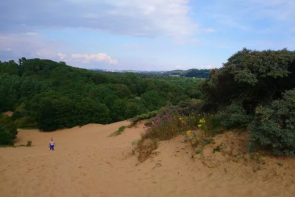
Merthyr Mawr Sand Dunes are sand dunes and a Site of Special Scientific Interest in Bridgend, south Wales. The village of Merthyr Mawr is nearby. The largest dune at the site is known as The Big Dipper and is the second-largest of its kind in Europe, measuring around 200 feet (61 m). Using our world travel planner, Bridgend attractions like Merthyr Mawr Sand Dunes can form part of a personalized travel itinerary.
2. Bryngarw Country Park, Bridgend:
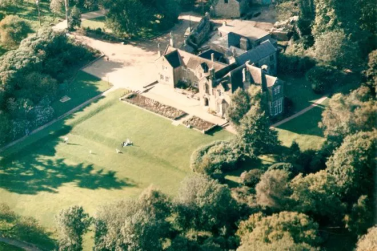
Bryngarw Country Park is made up of 48 hectares (120 acres) and is situated on the west bank of the Afon Garw, at the mouth of the Garw Valley in the Bridgend County Borough, Wales.
The western boundary is marked by the Brynmenyn-Bettws road and the River Garw is its eastern boundary. 18 hectares of open meadowlands, which are the subject of grazing tenancy agreements and hence not open to the public, surrounds the Country Park. The Country Park and Bryngarw House occupies the remaining 30 hectares of the estate. Bryngarw House and its associated formal gardens (including the lawn, shrubbery, lake and oriental gardens) account for 1.5 hectares of the park. The rest of the park is predominantly wooded (broadleaf, coniferous and mixed woodland) with areas of meadow, wetland and freshwater, formal garden and areas for amenity use. Bryngarw Country Park's mission statement is “Through the provision and maintenance of a mosaic of habitats, rich natural environments and historic formal gardens, with targeted access and interpretation; to provide a ‘Bridge’ for visitors, linking people and nature, past and present, urban and countryside, heritage and natural history And so to give access to the full range of physical, mental and social health benefits which that connection brings.” The park appears to be achieving this as it currently receives between 50,000 and 70,000 visitors per year; with visits made by local schools for educational and interpretative sessions run by the ranger team contributing between 1,500 and 2,000 children a year.” In addition to school visits, the ranger team provide a range of other interpretive events aimed at the general public.
In 2010, the park won its first Green Flag award for providing outstanding levels of conservation, preservation, sustainability and provision of public amenities and services. The park has again been deemed worthy of this prestigious award in 2011.
3. Barry Island Pleasure Park, Barry:
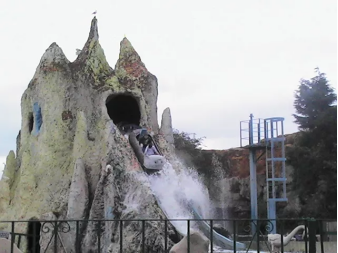
Barry Island Pleasure Park is an amusement park situated on the coast at Barry Island in the Vale of Glamorgan, about 10 mi (16 km) south west of the capital city Cardiff, Wales. The park opened annually at weekends from Easter onwards and daily during the school summer holidays, until the first weekend in September.
Barry Island contains shops, bars and restaurants. The Pleasure Park was once famous for its Scenic Railway which dominated half of the site in the mid-20th century, but was partially destroyed in a gale in 1973 before being dismantled. Many of the scenic railway's beams were used in the building of the Log Flume ride, which was one of the park's most popular attractions.
The Pleasure Park has over thirty attractions and rides. However lack of investment in the park resulted in the majority of these being removed, notably the Viper rollercoaster and the Log Flume. Park entrance is free of charge. Several Amusement arcades are located around the pleasure park.
Barry Island Pleasure Park is part owned by Ian Rogers, who ran Welsh discount chain Hypervalue before it ran into financial difficulties. In 2006, Hilco UK Ltd who specialise in dealing with failing retail businesses assumed control of the ailing Hypervalue group and commenced disposing of various Hypervalue stores and settling accounts with the many creditors. Mr Rogers now owns part of the reorganised group, renamed Hypa Xtra. The park was operated by showman Vernon Studt between 2010 and 2014 under a lease from the joint owners. Plan your visit to Barry Island Pleasure Park and a wealth of other attractions, well-known and undiscovered, using our Barry travel planner.
Reference Website:
https://www.inspirock.com/united-kingdom/things-to-do-in-bridgend
VI. History
Prehistoric and Roman
Several prehistoric burial mounds have been found in the vicinity of Bridgend, suggesting that the area was settled before Roman times. The A48 between Bridgend and Cowbridge has a portion, known locally as "Crack Hill", a Roman road and the 'Golden Mile' where it is believed Roman soldiers were lined up to be paid. The Vale of Glamorgan would have been a natural low-level route west to the Roman fort and harbour at Neath (Nidum) from settlements in the east like Cardiff and Caerleon (Isca).
Norman invasion
In the decades after the Norman conquest of Anglo-Saxon England in 1066, the Normans looked westwards to create new seats for lords loyal to William the Conqueror. Groups of Norman barons arrived in Wales, and in the south and east created what would later become the Welsh Marches, while the north and west remained largely unconquered.
At Coity, the local Welsh chieftain Morgan Gam already had a stronghold. Sometime in the 11th century, Norman Lord Payn de Turberville approached Morgan to turn over control of Coity Castle to Turberville. Morgan Gam agreed, on condition that Turberville either fought Morgan for the land, or took Gam's daughter Sybil's hand in marriage. Turberville married Sybil and became Lord of Coity, and rebuilt the castle.
Newcastle Castle (on Newcastle Hill, overlooking the town centre, 1106) and Ogmore Castle (1116) were built by Robert Fitzhamon and William de Londres, respectively. About 2 miles (3 km) north-east of Ogmore Castle, Maurice de Londres founded the fortified Benedictine Ewenny Priory in 1141 .These three castles provided a "defensive triangle" for the area – a quadrilateral if Ewenny Priory is included.
Early development
Bridgend developed at a ford on the River Ogmore, which was on the main route between east and west Wales. Just north of the town is the confluence of three rivers, the Ogmore, the Llynfi, and the Garw. South of Bridgend, the River Ewenny merges with the River Ogmore and flows into the Bristol Channel. In the 15th century, a stone bridge was built as a permanent connection between the two sides of the Ogmore (and was later rebuilt). Originally, this bridge had four arches, but in the 18th century, a massive flood washed two of them away. The rest of the bridge still stands and remains a focal point of the town: aesthetic restoration took place in 2006.Bridgend grew rapidly into an agricultural town. It became an important market town, a status it retained until the late 20th century.
New millennium
Objective 1 investment in regeneration and public realm improvements has led to the pedestrianisation of the town centre and the restoration of some buildings. Some local traders have argued that this has damaged trade due to a lack of access by taxis and the disabled. Car parking provision and pricing have also been a concern to retailers with calls for free or reduced-price parking to increase town centre visits.
To counteract the dominance of Tesco in the area, Asda were granted planning permission for a new superstore near the town centre. The store was opened on 31 March 2008 by the local MP, and players from Bridgend Ravens. Over 1500 customers were thought to have walked through the new doors to take a look around the new store.
In 2004, an award-winning new bus station was constructed and traffic movements around the town centre were altered. Local committees, together with the council, started to use the pedestrianisation of the town centre to its advantage, culminating in several fairs including Continental Markets, Celtic Festivals, a small Mardi-Gras, and seasonal markets and events. Bridgend Council estimated in 2009 that these events have brought 900,000 visitors to the town and generated around £53 million for the local economy.
VII. Culture
Nightlife
Several pubs, restaurants and a nightclub are located within the town centre.
In December 2008, Bridgend Council introduced its first alcohol-free zone, restricting the consumption of alcohol to pubs, clubs, and other licensed premises in the town centre to help address alcohol-related issues. CCTV is in operation throughout the town centre, and usually police have a presence of some form. Since July 2007, the streets of Bridgend are also patrolled on Friday and Saturday evenings by Street Pastors, an inter-denominational church response to urban problems, engaging with people on the streets.
Music
Those Damn Crows, Bullet for My Valentine and Funeral for a Friend are rock/metal acts from the borough which along with Jayce Lewis have received mainstream recognition. There are several smaller venues in and around the town centre including The New Angel Inn, The Railway Inn, Barracudas and Sapphires, which all host a number of open-mic nights. Bryan Adams played to a 15,000 crowd at Brewery Field stadium in the town in 2006. The Recreation Centre has hosted acts such as Fall Out Boy and Bring Me the Horizon.
Eisteddfodau
Bridgend hosted the National Eisteddfod in 1948. Bridgend County hosted the Urdd Gobaith Cymru National Eisteddfod in 2017.
Media
Bridgend has its own commercial radio station: 106.3 Bridge FM, and is the location of Internet-based radio station Celtica radio. The main local newspaper is The Glamorgan Gazette, although a free newspaper, The Recorder, has increased its circulation in recent times. Around Town magazine is the free local lifestyle magazine for Bridgend.
VIII. Other information
Bridgend Ravens
Bridgend Ravens (formally Bridgend RFC) are a semi-professional rugby union which formed in 1878 and play in the Welsh Premier Division. They play their home matches at the Brewery Field, which has been their home on and off since 1920. The club have been Welsh champions five times and have won the WRU Challenge Cup on two occasions, whilst also winning the WRU Division One West league in 2011 and numerous sevens competitions over the course of their existence. They have also played against international teams, New Zealand won on their visit in 1978, but Bridgend have beaten Italy, Western Samoa and Australia. The club has also hosted international matches at women and age grade.
Bridgend Athletic
Bridgend Athletic RFC was reformed in 1972, after the Bridgend Youth team members in that year wanted to form a senior team so they didn't have to go their separate ways into senior rugby, hence the formation of the club which had previously existed up to 1939. The club become full members of the Welsh Rugby Union in 1983. The club were promoted from Division 5 Central in 2001, were WRU Division Four East Champions in 2002, were then promoted from Division 3 to WRU Division Two West in 2003 through the league organisation and were promoted to Division 1 in 2004. They have suffered relegation from that league once, but bounced back in 2009, winning WRU Division Two West. They play in WRU Division One West.
Bridgend Sports
Bridgend Sports Rugby Football Club is a Welsh rugby union team based in Bridgend. Formed in 1938 by Victor Blick, the team survived the cessation of club rugby in Wales between 1939 and 1945, during the Second World War. There have been in existence at least two other clubs in Bridgend throughout the club's history providing local competition. The club is a member of the Welsh Rugby Union and play in the WRU Division Four South East. They won the Glamorgan County Silver Ball Trophy on three successive years between 1979 and 1981, and were champions of WRU Division Five South Central in 2010.
Celtic Warriors
The Celtic Warriors, formed in 2003, are a defunct regional rugby union team that was mainly based at the Brewery Field in Bridgend. When regional rugby was enforced by the Welsh Rugby Union, Bridgend RFC and Pontypridd RFC, who were both professional clubs at the time, merged to create the Celtic Warriors as one of the five new regional rugby teams in Wales. However, they were dissolved after one season due to financial problems that had plagued the club. Pontypridd RFC had sold their share of the region early on due to their own financial difficulties, with the remaining share which had been owned by Bridgend RFC, being sold off to the Welsh Rugby Union at the end of the season. This led to the winding up of the Celtic Warriors region by the WRU, as there was not enough money to keep the region afloat. There were high points for the region: 10,000 turned up to watch them face European champions-in-waiting London Wasps and even beat the Wasps 9–14 at Adam's Park a week earlier. The team finished 4th out of 12 in the Celtic League in their only season of existence.
Ospreys Rugby
The Ospreys were formed in 2003 after the merger of Neath RFC and Swansea RFC, which took place after the Welsh Rugby Union forced through regional rugby as the top level of Welsh rugby. Bridgend became part of this region following the demise of the Celtic Warriors. Although the Ospreys play their home matches at the Liberty Stadium in Swansea, since 2010 they have played their home Anglo-Welsh Cup home games at the Brewery Field, which is normally two games a season.
Soccer
Bridgend had two football teams, Bridgend Town A.F.C., and a Bridgend suburb side Bryntirion Athletic F.C. that played in the Welsh Football League First Division. Bridgend Town AFC from 2009 played at The Brewery Field (The Football Club purchased The Brewery Field in 2009) as the club sold its ground at Coychurch Road ground due to works in conjunction with the new Asda store. In 2013, the two clubs joined to form Pen-y-Bont F.C. who, following promotion in 2019, play in the Welsh Premier League, the top level of Welsh football. They are currently managed by Rhys Griffiths. Bridgend's geographical position means South Wales rivals Cardiff City and Swansea City pick up support from the town.
IX. Contact information
Mayor/Officer: Alan Wathan
Tel: 01656 815757
Mail: bridgend.tc@bridgend.gov.uk
Reference Website:
http://www.bridgendtowncouncil.gov.uk/latest-news.aspx
